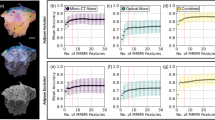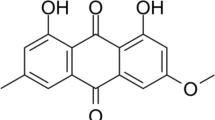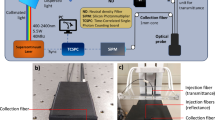Abstract
Photodynamic diagnosis is of increasing interest for diagnosis in oncology. It is based on a more intense incorporation of a fluorescent dye in tumours compared to normal tissue. As a feasibility study we investigated the effectiveness of oral application of 5-aminolevulinic acid for photodynamic diagnosis of human primary mammary tumours. The study included 16 patients with palpable breast tumours. Aminolevulinic acid was administered at a concentration of 40 mg kg−1 bodyweight 150–420 min prior to tumourectomy. Intraoperatively blue light (405 nm) was applied to the operation site. Sections of the excised tumour and some lymph nodes were prepared and analysed with a fluorescent microscope. All primary mammary tumour tissues showed significantly higher fluorescence intensity than surrounding normal mammary tissue. Fluorescence of the mammary tumours could also be discriminated macroscopically and intraoperatively. Fluorescence intensity in nonmetastatic lymph node tissue was higher in 2 out of 3 patients than in primary tumour tissue. By photodynamic diagnosis using aminolevulinic acid we were able to reliably distinguish primary mammary tumours from normal mammary tissue microscopically and macroscopically in all our patients. We suggest that photodynamic diagnosis with aminolevulinic acid for breast tumours should be further investigated and developed for intraoperative use and may well be a simple tool for better intraoperative diagnosis and recognition of tumour margins. We hypothesize that lymph node metastasis of breast tumours will not be detectable by this method. © 2001 Cancer Research Campaign
Similar content being viewed by others
Article PDF
Change history
16 November 2011
This paper was modified 12 months after initial publication to switch to Creative Commons licence terms, as noted at publication
References
Campbell DL, Gudgin-Dickson EF and Forkert PG (1996) Detection of early stages of carcinogenesis in adenoma of murin lung by 5-aminolevulinic acid-induced protoporphyrin IX fluorescence. Photochem Photobiol 64: 676–682
Dougherty TJ and Marcus SL (1992) Photodynamic therapy. Eur J Cancer 28A: 1734–1742
Eleouet S, Carre J and Vonarx V (1997) Delta-aminolevulinic acid-induced fluorescence in normal human lymphocytes. J Photochem Photobiol B 41: 22–29
Fehr MK, Chapman CF and Krasieva T (1996) Selective photosensitizer distribution in vulvar condyloma acuminatum after topical application of 5-aminolevulinic acid. Am J Obstet Gynecol 174: 951–957
Gannon MJ, Johnson N and Roberts DJH (1995) Photosensitization of the endometrium with topical 5-aminolevulinic acid. Am J Obstet Gynecol 173: 1826–1828
Gibson SL, Havens JJ, Foster TH and Hilf R (1997) Time-dependent intracellular accumulation of delta-aminolevulinic acid, induction of porphyrin synthesis and subsequent phototoxity. Photochem Photobiol 65: 416–421
Henderson BW and Dougherty TJ (1992) How does photodynamic therapy work? Review. Photochem Photobiol 55: 145–157
Heyerdahl H, Wang I and Liu DL (1997) Pharmacokinetics studies on 5-aminolevulinic acid-induced protoprophyrin IX accumulation in tumors and normal tissue. Canc Lett 112: 225–231
Hua Z, Gibson SL, Foster TH and Hilf R (1995) Effectiveness of delta-aminolevulinic acid-induced protoporphyrin as a photosensitizer for photodynamic therapy in vivo. Cancer Research 55: 1723–1731
Kato H, Okunaka T and Shimatani H (1984) Clinical measurement of tumor fluorescence using a new diagnostic system with hematoporphyrin derivative, laser photoradiation, and a spectroscope. Lasers Surg Med 4: 49–58
Kennedy JC and Pottier RH (1992) Endogenous protoporphyrin IX, a clinically useful photosensitizer for photodynamic therapy. J Photochem Phtobiol B 14: 275–292
Kennedy JC and Pottier RH (1994) Using delta-aminolevulinc acid in cancer therapy. Porphyric pesticides,
Kennedy JC, Pottier RH and Pross DC (1990) Photodynamic therapy with endogenous protoporphyrin IX: basic principles and present clinical experience. J Photochem Photobiol B 6: 143–148
Khan SA, Dougherty TJ and Mang TS (1993) An evaluation of photodynamic therapy in the management of cutaneous metastases of breast cancer. Eur J Cancer 29A: 1686–1690
Krammer B and Uberriegler K (1996) In-vitro investigation of ALA-induced protoporphyrin IX. J Photochem Photobiol B 36: 121–126
Kriegmair M, Baumgartner R and Knuechel R (1994) Fluorescence photodetection of neoplastic urothelial lesions following intravesical instillation of 5-aminolevulinic acid. Urology 44: 836–841
Leuing A, Rick K and Stepp H (1996) Fluorescence imaging and spectroscopy of 5-aminolevulinic acid induced protoporphrin IX for the detection of neoplastic lesions in the oral cavity. Am J Surg 172: 674–677
Loh CS, MacRobert AJ and Bedwell J (1993) Oral versus intravenous administration of 5-aminolaevulinic acid for photodynamic therapy. Br J Cancer 68: 41–51
Marcus SL, Sobel RS and Golub AL (1996) Photodynamic therapy (PDT) and photodiagnosis (PD) using endogenous photosensitization induced by 5-aminolevulinic acid (ALA): current clinical and development status. J Clin Laser Med Surg 14: 59–66
Navone NM, Polo CF and Frisardi AL (1990) Heme biosynthesis in human breast cancer-mimetic “in vitro” studies and some heme enzymic acitivty levels. Int J Biochem 22: 1407–1411
Obwegeser A, Jakober R and Kostron H (1998) Uptake and kinetics of 14C-labelled meta- tetrahydroxyphenylchlorin and 5-aminolaevulinic acid in the C6 rat glioma model. Br J Cancer 78: 733–738
Peng Q, Moan J and Warloe T (1992) Distribution and photosensitizing efficiency of porphyrins induced by application of exogenous 5-aminolevulinic acid in mice bearing mammary carcinoma. Int J Cancer 52: 433–443
Peng Q, Warloe T and Berg K (1997) 5-Aminolevulinic acid-based photodynamic therapy. Cancer 79: 2282–2308
Riesenberg R, Fuchs C and Kriegmair M (1996) Photodynamic effects of 5-aminolevulinic acid-induced porphyrin on human bladder carcinoma cells in vitro. Eur J Cancer 32A: 328–334
Steiner RA, Tadir Y and Tromberg BJ (1996) Photosensitization of the rat endometrium following 5-aminolevulinic acid induced photodynamic therapy. Lasers Surg Med 18: 301–308
Svanberg K, Wang I and Colleen S (1998) Clinical multi-colour fluorescence imaging of malignant tumours – initial experience. Acta Radiol 39: 2–9
Van den Boogert J, Van Hillegersberg R and De Rooij FW (1985) 5-Aminolaevulinic acid-induced protoporphyrin IX accumulation in tissues: pharmacokinetics after oral or intravenous administration. J Photochem Photobiol B 44: 29–38
Webber J, Kessel D and Fromm D (1997) Side effects and photosensitization of human tissues after aminolevulinic acid. J Surg Res 68: 31–37
Author information
Authors and Affiliations
Rights and permissions
From twelve months after its original publication, this work is licensed under the Creative Commons Attribution-NonCommercial-Share Alike 3.0 Unported License. To view a copy of this license, visit http://creativecommons.org/licenses/by-nc-sa/3.0/
About this article
Cite this article
Ladner, D., Steiner, R., Allemann, J. et al. Photodynamic diagnosis of breast tumours after oral application of aminolevulinic acid. Br J Cancer 84, 33–37 (2001). https://doi.org/10.1054/bjoc.2000.1532
Received:
Revised:
Accepted:
Published:
Issue date:
DOI: https://doi.org/10.1054/bjoc.2000.1532
Keywords
This article is cited by
-
Intraoperative fluorescence imaging with aminolevulinic acid detects grossly occult breast cancer: a phase II randomized controlled trial
Breast Cancer Research (2021)
-
ABCG2 transporter inhibitor restores the sensitivity of triple negative breast cancer cells to aminolevulinic acid-mediated photodynamic therapy
Scientific Reports (2015)
-
Successful in vivo tumor visualization using fluorescence laparoscopy in a mouse model of disseminated alveolar rhabdomyosarcoma
Surgical Endoscopy (2015)
-
Early neoplastic and metastatic mammary tumours of transgenic mice detected by 5-aminolevulinic acid-stimulated protoporphyrin IX accumulation
British Journal of Cancer (2005)
-
Photodynamic detection of diseased axillary sentinel lymph node after oral application of aminolevulinic acid in patients with breast cancer
British Journal of Cancer (2004)



